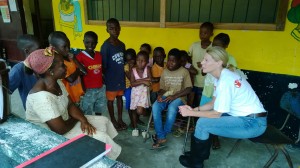I am not sure that in my 16 years with Save the Children that I have seen—and felt myself—such palpable fear in a place as I did last week in Liberia. But it is a fear that comes at you in waves, an undercurrent that runs under what looks on the surface to be the normal daily life of a very poor country in West Africa.
In the market, people are going about their business, buying and selling wares, going to work, cooking in small sidewalk stalls. But right away you start to notice the billboards, the signs, all calling out that Ebola is real and what to do to keep safe. You see the washing stations at every store, every stopping point—and after just a few hours, the fear starts to seep in. My colleagues point out the sirens, signaling another Ebola case has been picked up, and images of the victims flash through my head.
The fear comes as I wash my hands in chlorinated water from a small bucket with a spout everywhere I go, as my shoes are sprayed with the same chlorine solution each time I get in and out of a vehicle or go into a building, as I try to remember to shake hands with no one, to touch no one, to not get too close, even to my own colleagues. Fear comes with the constant message on the radio inside the car as we drive—”Ebola kills”—over and over again.
But the real face of fear in this epidemic is in the faces of the families and children I met – children and families that have lost mothers, fathers, wives and husbands, brothers and sisters. Those who have survived quarantines, but who are now shunned by their communities and cut off from basic services. I see the fear in the children I met who have been orphaned by the virus and are living in makeshift shelters, under houses, inside storerooms. Whole families of children living day-to-day as best they can without their parents. Their fear, and the fear of those around them, shows starkly in their eyes. 
There are an estimated 3,700 orphans across the three hardest hit countries of Liberia, Sierra Leone, and Guinea. In Liberia alone, the number is estimated at 2,000, with new children becoming orphans each day as the virus ravages mothers and fathers. One little girl I met, seven year-old Elizabeth, was living under a house with her older brother just steps away from where their mothers body had been taken over a month ago. They had come and burned all their belongings and sprayed down the room but the children would not go back inside. While they survived the 21 day incubation period, they now faced the prospect of starvation and stigma as people in their town are too scared to even look at them.
One of the key pieces of our response is to work with the Department of Social Welfare in Liberia to ensure we know where these children are and get them basic survival kits which include food, household items, soap and hygiene supplies and clothing. Then we begin to try to reunite them with extended family whenever and wherever possible, a painstaking process to trace family members that may be hundreds of miles away.
But the bigger issue in this crisis is breaking the back of transmission of the disease, reducing the reproductive rate of cases to below 1—and bringing down the fear. The messages, chlorinated water, and radio programs have done part of their job but people must leave their houses and get into care and stop infecting others at the first sign of symptoms. Tragically, there is just not enough care and beds available.
Save the Children is building 10 Community Care Centers in Margibi county—smaller centers where people can go and get tested, where those testing positive are isolated from others before being transferred to a more sophisticated Ebola Treatment Unit, getting basic care while waiting for a bed and receiving visits from a mobile team of doctors and nurses. We are also building an additional Ebola Treatment Unit to serve Margibi, one of the epicenters of the epidemic, modeled after a center we already built in Bong County.
While the fear of this visit was very real, there was also hope. In my last hours in Liberia, I visited a transition center for orphaned children in Montserrado, with 10 children who still could not yet be reunited with their families. While you could still see traces of fear and certainly sadness in their eyes, they lit up when asked to sing a song and proudly told me about their dreams. One little boy, Edward, told me with a confident smile, that he wanted to be President. Right at that moment, I believed it could come true, if we could just end the fear and death all around us that have no place in a child’s life.
Please help us do more to halt the outbreak and provide lifesaving outreach and protection for children.

